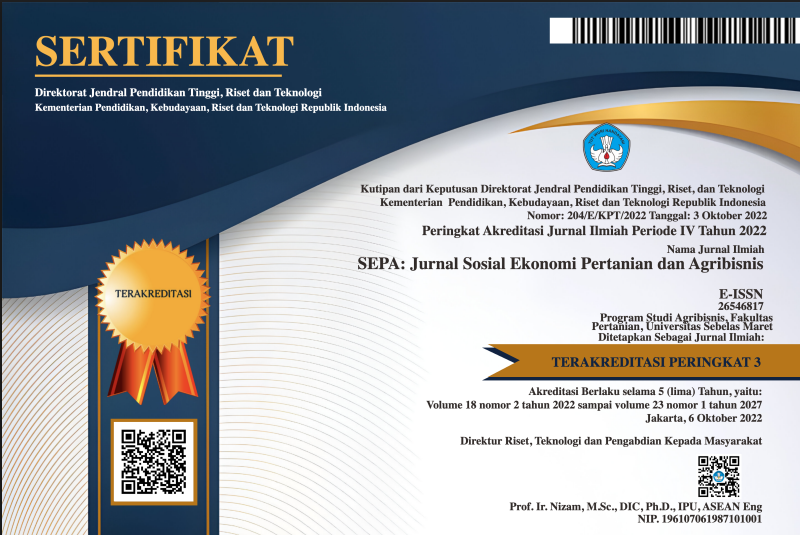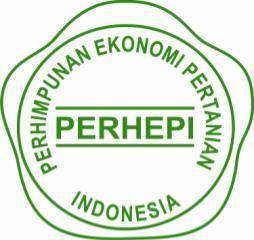DAYA SAING KOMODITAS PERTANIAN UNGGULAN INDONESIA: PERBANDINGAN DENGAN NEGARA LAIN DI ASEAN DAN POTENSINYA
Abstract
Keywords
Full Text:
PDFReferences
Ambastha, A., & Momaya. (2004). Competitiveness of firms: review of theory, frameworks, and models. Singapore Management Review, 26(1): 45–61.
Badan Pusat Statistik. (2021). Analisis Komoditas Ekspor, 2013-2020, Sektor Pertanian, Industri dan Pertambangan. Jakarta: BPS RI.
Barragan, S. (2005). Assessing the power of Porters' diamond model in the automobile industry in Mexico after ten years of NAFTA. Retrieved from https://www.uleth.ca/dspace/handle/10133/586.
Baso, R. L., & Anindita, R. (2018). Analisis daya saing kopi Indonesia.Jurnal Ekonomi Pertanian dan Agribisnis (JEPA), 2(1): 1–9.
Halwani, R. (2005). Ekonomi Internasional dan Globalisasi Ekonomi. Bogor: Ghalia Indonesia.
Jannati, F., Marsudi, E., & Fauzi, T. (2020). Analisis daya saing ekspor teh Indonesia dan teh Vietnam di pasar dunia. Jurnal Ilmiah Mahasiswa Pertanian, 5(1): 181–190.
Kurniato, D. T., Suharyono, & Mawardi, K. (2016). Daya saing komoditas lada Indonesia di pasar internasional. Jurnal Administrasi Bisnis (JAB), 40(2): 58–64.
Parnadi, F., & Loisa, R. (2018). Analisis daya saing ekspor kopi Indonesia di pasar internasional. Jurnal Manajemen Bisnis dan Kewirausahaan, 2(4): 52–61. http://dx.doi.org/10.24912/jmbk.v2i4.4863.
Permatasari, I.G.A.I, & Rustariyuni, S.D. (2015). Analisis daya saing ekspor biji kakao Indonesia di kawasan ASEAN periode 2003-2012. E-Jurnal EP Unud. 4(7): 855–872.
Sabaruddin, S.S. (2014). The impact of Indonesia-China trade liberalisation on the welfare of Indonesian society and on export competitiveness. Bulletin of Indonesian Economic Studies, 50(2), 292–293.
Salvatore, D. (2013). International Economics Eleventh edition. New York: John Wiley and Sons Inc.
Saragih, F.H., Darwanto, D.H., & Masyhuri. (2013). Analisis daya saing ekspor minyak kelapa sawit (CPO) Sumatera Utara di Indonesia. Agro Ekonomi, 24(1), 37–49. https://doi.org/ 10.22146/ agroekonomi.17695.
Suhartini, & Yuliawati, E. (2015). Faktor-faktor yang memengaruhi analisis daya saing industri baik industri batik berbasis diamond porter modelling. Prosiding Seminar Nasional Multi Disiplin Ilmu Unisbank.
Sukirno, S. (2006). Makroekonomi Teori Pengantar Edisi Ketiga. Jakarta: PT Raja Grafindo Perkasa.
Tambunan, T. (2004). Globalisasi dan Perdagangan Internasional. Bogor: Ghalia Indonesia.
UN Comtrade. (2021). International Trade Statistics Database (online). Retrieved from https://comtrade.un.org/data/.
Zakariyah, M.Y., Anindita, R., & Baladina, N. (2014). Analisis daya saing teh Indonesia di pasar internasional. AGRIMETA: Jurnal Pertanian Berbasis Keseimbangan Ekosistem, 4(8): 29–37.
DOI: https://doi.org/10.20961/sepa.v19i1.53322
Refbacks
- There are currently no refbacks.



.png)







.png)
3.png)





